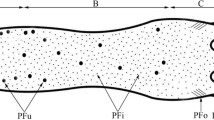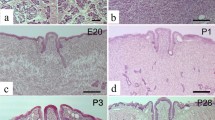Summary
In the present study carbohydrate residues in taste buds (TBs) and adjacent epithelial formations of a teleostean fish, a frog and the rabbit were detected by means of lectin histochemistry. Biotinylated lectins fromPisum sativum (PSA),Arachis hypogaea (PNA),Dolichos biflorus (DBA),Triticum vulgaris (WGA and succinylated WGA),Glycine max (SBA) andUlex europaeus (UEA I) have been applied. The lectins were bound to an avidin-biotin-peroxidase-complex (ABC) and visualized by diaminobenzidine/ H2O2. Most intensive reactivity was observed at the taste dise cells of the frog with DBA, S-WGA and SBA. PNA did not bind to the TBs of any of the animals tested. As shown in SBA preparations, sialic acid is present in a nonacylated and an acylated form in the mucosa of the frog's tongue. The TBs of the fish possess all the sugars we looked for except for the disaccharided-galactose-(1–3)-β-d-N-acetyl-galactosamine (Gal/GalNAc) and sialic acid. The TBs of the rabbit contain GalNAc, as detected with DBA, but not with SBA; and fucose (Fuc), mannose (Man) andN-acetyl-glucosamine (GlcNAc). As revealed by preincubation of the tissue sections with neuraminidase in TB cells of the rabbit, sialic acid masks Gal/GalNAc and GalNAc. These lectin-binding characteristics show that in the TBs of some selected representatives which belong to different vertebrate classes exist different mucous substances. These substances possess different binding characteristics to specific sugars, and this is possibly of particular interest to chemoreception phenomena.
Similar content being viewed by others
References
Allen A (1983) Mucus — a protective secretion of complexity. TIBS 8:169–173
Allen WK, Akeson R (1985) Identification of a cell surface glyco-protein family of olfactory receptor neurons with a monoclonal antibody. J Neurosci 5:284–296
Andres KH (1975) Neue morphologische Grundlagen zur Physiologie des Riechens und Schmeckens. Arch Otorhinolaryngol 210:1–41
Ashwell G, Morell AG (1974) The role of surface carbohydrates in the hepatic recognition and transport of circulating glycoproteins. Adv Enzymol 41:99–128
Bannister LH (1974) Possible functions of mucus at gustatory and olfactory systems. In: Poynder TM (ed) Transduction mechanisms in chemoreception. Information Retrieval, London, pp 39–48
Caprio J, Byrd RP Jr (1984) Electrophysiological evidence for acidic, basic, and neutral amino acid olfactory receptor sites in the catfish. J Gen Physiol 84:403–422
Carmignani MPA, Zaccone G (1977) Histochemical studies on the tongue of anuran amphibians. II. Comparative morphometrical study of the taste buds and the lingual glands inBufo viridis Laurenti andRana graeca Boulenger with particular reference to the mucosaccharide histochemistry. Cell Mol Biol 22:203–217
Carmignani MPA, Zaccone G, Cannata F (1975) Histochemical studies on the tongue of anuran amphibian. I. Mucopolysaccharide histochemistry of the papillae and the lingual glands inHyla arborea L.,Rana esculenta L., andBufo vulgaris Laur. Ann Histochim 20:47–65
Chen Z, Ophir D, Lancet D (1986) Monoclonal antibodies to ciliary glycoproteins of frog olfactory neurons. Brain Res 368:329–338
Culling CFA, Reid PE (1982) Histochemistry of sialic acids. In: Schauer R (ed) Sialic acids. Chemistry, metabolism and function. Cell Biol Monographs, vol 10. Springer, Wien, pp 173–193
Düring M v, Andres KH (1976) The ultrastructure of taste and touch receptors of the frog's taste organ. Cell Tissue Res 165:185–198
Etzler ME, Kabat EA (1970) Purification and characterization of a lectin (plant hemagglutinin) with blood group A specificity fromDolichos biflorus. Biochemistry 9:869–877
Farbman AI, Ogdan-Ogle CK, Hellekant G, Simmons SR, Albrecht RM, van der Wel A (1987) Labeling of sweet taste binding sites using a colloidal gold-labeled-sweet protein, Thaumatin. Scanning Electron Microsc 1:351–357
Graham RC, Karnovsky MJ (1966) The early stages of absorption of injected horse-radish peroxidase in the proximal tubules of mouse kidney: Ultrastructural cytochemistry by a new technique. J Histochem Cytochem 14:291–302
Graziadei PPC, de Han RS (1971) The ultrastructure of frog's taste organs. Acta Anat 80:563–603
Grover-Johnson N, Farbman AI (1976) Fine structure of taste buds in the barbel of the catfish,Ictalurus punctatus. Cell Tissue Res 169:395–403
Holland KN, Teeter JH (1981) Behavioral and cardiac reflex assays of the chemosensory acuity of channel catfish to amino acids. Physiol Behav 27:699–707
Hsu SM, Raine L (1982) Versatility of biotin-labeled lectins and avidin-biotin-peroxidase complex for localization of carbohydrate in tissue sections. J Histochem Cytochem 30:157–161
Jaeger CB, Hillman DE (1976) Morphology of gustatory organs. In: Llinas R, Precht W (eds) Trog neurobiology. Springer, Berlin Heidelberg New York, pp 588–606
Jeppsson PH (1969) Studies on the structure and innervation of taste buds. An experimental and clinical investigation. Acta Otolaryngol (Suppl) (Stockh) 259:1–95
Key B, Biorgi PP (1986) Selective binding of soybean agglutinin to the olfactory system ofXenopus. Neuroscience 18:505–515
Kornfeld R, Kornfeld S (1980) Structure of glycoprotein and their oligosaccharide units. In: Lennarz WJ (ed) The biochemistry of glycoproteins and proteoglycans. Plenum Press, New York London, pp 1–34
Lev R, Spicer SS (1965) A histochemical comparison of human epithelial mucins in normal and hypersecretory states including pancreatic cystic fibrosis. Am J Pathol 46:23–47
Lotan RE, Skutelsky E, Danon D, Sharon N (1975) The purification, composition and specificity of the anti-T lectin from peanut (Arachis hypogaea). J Biol Chem 250:8518–8523
Mendoza AS, Kühnel W (1987) Lektinbindungsstellen an olfaktorjschen Epithelformationen der Maus. Anat Anz 163:167
Murray RG (1973) The ultrastructure of taste buds. In: Friedemann I (ed) The ultrastructure of sensory organs. North-Holland, Amsterdam London, pp 1–81
Pereira MEA, Kisailus EC, Gruezo G, Kabat EA (1978) Immunochemical studies on the combining site of the blood-group H specific lectin I fromUlex europaeus seeds. Arch Biochem Biophys 185:108–115
Pierce JG, Parsons TF (1981) Glycoprotein hormones: Structure and function. Annu Rev Biochem 50:465–495
Reutter K (1978) Taste organ in the bullhead (Teleostei). Adv Anat Embryol Cell Biol 55:1–98
Reutter K (1986) Chemoreceptors. In: Bereiter-Hahn J, Matoltsy AG, Richards KS (eds) Biology of the integument. Vol 2: Vertebrates. Sprigner, Berlin Heidelberg New York, pp 586–604
Reutter K, Klessen CH (1979) Vergleichend — kohlenhydrathisto-chemische Untersuchung der Geschmacksknospen niederer und höherer. Wirbeltiere. Verh Anat Ges 73:1019–1021
Reutter K, Witt M (1987) Comparative lectinhistochemical investigation of the taste buds of different vertebrates. Chem Senses 12:188–189
Romeis B (1968) Mikroskopische Technik. 16. Aufl. R Oldenbourg, München Wien
Sato T, Sugimoto K, Okada Y (1982) Ionic basis of receptor potential in frog taste cell in response to salt stimuli. Jpn J Physiol 32:459–462
Schulte BA, Spicer SS (1985) Histochemical methods for characterizing secretory and cell surface sialoglycoconjugates. J Histochem Cytochem 33:427–438
Shepherd GM, Getchell TV, Mistretta CM (1986) Questions of taste and smell. Nature 324:17–18
Stoward PJ, Spicer SS, Miller RL (1980) Histochemical reactivity of peanut lectin — horseradish peroxidase conjugate. J Histochem 28:979–990
Uhlenbruck G, Beuth HJ, Oette K, Schotten T, Ko HL, Roszkowski K, Roszkowski W, Lüttiken R, Pulverer G (1986) Lektine und die Organotropie der Metastasierung. Dtsch Med Wochenschr 111:991–995
Witt M, Reutter K (1986) Vergleichend-kohlenhydrathistochemische Untersuchung der Geschmacksknospen niederer und höherer Wirbeltiere mit biotinylierten Lektinen. Verh Anat Ges (in press)
Zaccone G (1983) Histochemical studies of acid proteoglycans and glycoproteins and activities of hydrolytic and oxidoreductive enzymes in the skin epidermis of the fishBlennius sanguinolentus Pallas(Teleostei: Blenniidae). Histochemistry 78:163–175
Zaccone G (1984) Histochemical studies of oxidoreductases, acid carbohydrates and glycoproteins in the epidermis of the electric eelElectrophorus electricus. Basic Appl Histochem 28:29–40
Author information
Authors and Affiliations
Additional information
Dedicated to Professor Dr. T.H. Schiebler on the occasion of his 65th birthday.
Supported by the Deutsche Forschungsgemeinschaft (Re 225/9-1)
Rights and permissions
About this article
Cite this article
Witt, M., Reutter, K. Lectin histochemistry on mucous substances of the taste buds and adjacent epithelia of different vertebrates. Histochemistry 88, 453–461 (1988). https://doi.org/10.1007/BF00570308
Accepted:
Issue Date:
DOI: https://doi.org/10.1007/BF00570308




